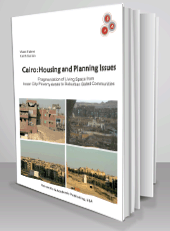Scientific & Academic Publishing
SAP is an open access publisher of journals covering a wide range of academic disciplines.
SAP is an open access publisher of journals covering a wide range of academic disciplines.

Wael Salah Fahmi was trained as an architect at Cairo University and received his PhD in Planning and Landscape from the University of Manchester (UK). He is an Associate Professor at the Architecture Department, Helwan University in Cairo.
Keith Sutton lectured in Geography at the University of Manchester (United Kingdom), specializing in Third World and North African courses.
Wael and Keith have been undergoing joint research on Greater Cairo’s urban growth problems and housing crisis, the rehabilitation of historical Cairo, the cemetery informal settlements and the garbage collectors’ community, and Cairo's 19th century and early 20th century contested European Quarter and architectural heritage.
Description
This book examines Greater Cairo’s housing access and vacancy, suburban gated communities and resettlement sites, particularly in New Cairo City. The empirical research investigates the complex reasons for the failure of various policies (Greater Cairo Region Master Plan, New Settlements schemes, New Towns) in meeting housing needs of the urban poor, focusing especially on inner city tomb dwellers (Cities of the Dead) and on Zabaleen garbage collectors. The new settlement housing proved to be too expensive for the urban poor, thus eventually attracting speculators rather than residents. This has resulted in the emergence of nearly empty New Towns, and the increasing fortification of the affluent nouveaux riche within exclusive desert condominiums and gated communities. These communities are regarded as fortresses of leisure, consumption and socio-spatial segregation in the context of global (golf) tourism and real estate marketing, a phenomenon that aggravated social injustice and housing inequality. A stakeholder approach is proposed which would involve grass-roots co-operation between urban poor population, local NGOs, urban planners and official authorities to resolve the phenomenon of ‘dwellings without dwellers and dwellers without dwellings’ which are to be found in practically all districts of Greater Cairo.
Table of Contents
| Preface | 5 |
| Chapter One: Greater Cairo Master Plans | 9 |
| Master Plans for Cairo | 11 |
| Late 1990s Out-turns using the 1996 Census results | 19 |
| Factors Behind the Relative Failure of Cairo's Master Plans | 29 |
| Future Scenarios | 39 |
| Chapter Two: Greater Cairo Region's Housing Crisis | 47 |
| Housing Access | 47 |
| Vacant Dwellings | 50 |
| Housing Policies and Legislative Development | 60 |
| Housing Cooperatives | 61 |
| Urban Youth Housing | 61 |
| Privately Owned Housing | 63 |
| Rental Housing | 64 |
| Earlier Housing Rent Control Laws - 1950s-1980s | 66 |
| Modifications to Rent Control Law 1996 | 69 |
| Recent Mortgage Law 200 | 71 |
| Would the Mortgage Law benefit the rich or the poor? | 73 |
| Chapter Three: Cairo's 'Cities of the Dead' and the Eviction of Tomb Dwellers | 75 |
| The Location and Origins of the Cemeteries and their Residents | 78 |
| Socio-Economic Characteristics of the Tomb Dwellers | 92 |
| Social Structures and Social Stigmas and Built Environment Conditions | 99 |
| Scenarios and Plans | 104 |
| Clearing Bab El-Nasr Cemetery | 108 |
| The Future of the Cemeteries | 112 |
|
Chapter Four: Cairo’s Contested Garbage City and the Privatisation of Solid
Waste Management |
119 |
| History of the Zabaleen Garbage Collectors | 121 |
| The Muqattam Zabaleen Community | 124 |
| Population Growth | 128 |
| Zabaleen Environmental Development Program (ZEDP) | 129 |
| Community Based Micro-Enterprises | 131 |
| Change in Land Tenure Practices | 132 |
| Physical Development of the Zabaleen Settlement | 133 |
| Land Use Changes | 134 |
| Housing Conditions | 135 |
| Urban Development | 139 |
| Privatization of Waste Management Systems | 141 |
| Stakeholders’ Analysis of Attitudes towards the Privatization | |
| Programme and Proposed Relocation Plans | 144 |
| Recycling Activities and Housing Conditions | 149 |
| Community Livelihood and Social Cohesion | 151 |
| Political Achievement | 152 |
| Technical Improvement | 154 |
| Community Empowerment and Networking | 155 |
| Environmental Awareness | 157 |
| The Swine Flu Pandemic and the Slaughtering of the Zabaleen’s Pigs | 158 |
| The Proposed Relocation Plan | 162 |
| The Future of Garbage City | 163 |
|
Chapter Five: Gated Communities within Greater Cairo Region .The Case of New Cairo City |
174 |
| Heteropology of Gated Communities | 174 |
| Gated Resorts East and West Greater Cairo Region | 180 |
| Golf Tourism in Egypt and Emergence of Gated Enclaves (Cairotopias) | 182 |
| New Cairo City’s Contested Housing | 190 |
| Stakeholders’ Narratives and Contested Landscape | 192 |
| Gated Communities and Golf Resorts for the Rich -New Settlement (No. 5) | 194 |
| Resettlement Housing for the Poor –New Settlement (No. 3) | 204 |
| Primary Stakeholders’ Attitudes and Evaluations | 211 |
| Vacant Dwellings within Survey Areas | 216 |
| Chapter Six: Greater Cairo Region’s Housing Future | 222 |
| Housing Access | 222 |
| Vacant Dwellings | 223 |
| Gated Communities | 224 |
| Resettlement Sites | 227 |
| A Stakeholder Approach | 229 |
| Bibliography | 231 |
| Endnotes | 246 |